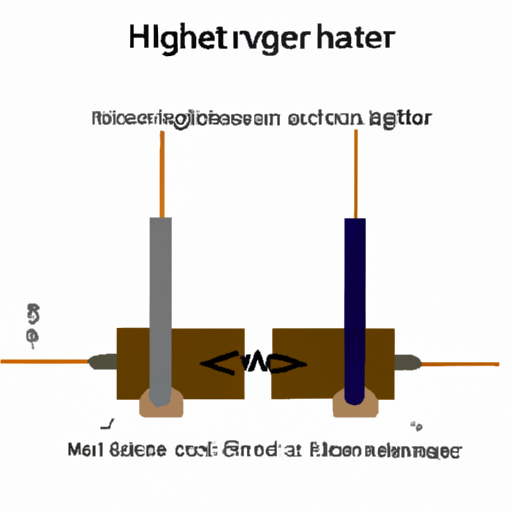Understanding High Voltage Resistors

I. Introduction
In the world of electronics, resistors play a crucial role in controlling the flow of electric current. Among the various types of resistors, high voltage resistors are particularly significant due to their ability to handle elevated voltage levels safely and effectively. This article aims to provide a comprehensive understanding of high voltage resistors, their characteristics, applications, and safety considerations, ensuring that readers are well-informed about this essential component in electrical and electronic systems.
II. Basics of Resistors
A. What is a Resistor?
A resistor is a passive electrical component that limits or regulates the flow of electric current in a circuit. Its primary function is to provide resistance, which is measured in ohms (Ω). Resistors are fundamental in various applications, from simple circuits to complex electronic devices.
1. Function and Purpose
The primary purpose of a resistor is to control current flow, divide voltages, and protect sensitive components from excessive current. By doing so, resistors help maintain the desired performance of electronic circuits.
2. Types of Resistors
Resistors come in various types, including fixed, variable, and specialty resistors. Fixed resistors have a constant resistance value, while variable resistors, such as potentiometers, allow users to adjust the resistance. Specialty resistors are designed for specific applications, such as high voltage or high power.
B. Understanding Resistance and Ohm's Law
1. Definition of Resistance
Resistance is the opposition to the flow of electric current, and it is determined by the material, length, and cross-sectional area of the resistor. The higher the resistance, the less current will flow for a given voltage.
2. Relationship Between Voltage, Current, and Resistance
Ohm's Law, a fundamental principle in electronics, states that the current (I) flowing through a conductor between two points is directly proportional to the voltage (V) across the two points and inversely proportional to the resistance (R). This relationship is expressed mathematically as:
\[ V = I \times R \]
Understanding this relationship is crucial for designing and analyzing electrical circuits.
III. High Voltage Resistors: An Overview
A. Definition and Characteristics
High voltage resistors are specifically designed to operate safely at elevated voltage levels, typically above 1,000 volts. These resistors are built to withstand high electrical stress without breaking down or failing.
1. Voltage Ratings and Classifications
High voltage resistors are classified based on their voltage ratings, which indicate the maximum voltage they can handle without risk of failure. Common classifications include low, medium, and high voltage resistors, with high voltage resistors rated for thousands of volts.
2. Physical Construction and Materials Used
The construction of high voltage resistors often involves materials that can withstand high temperatures and electrical stress. Common materials include ceramic, metal oxide, and wirewound elements, which provide durability and reliability.
B. Comparison with Standard Resistors
1. Differences in Design and Application
High voltage resistors differ from standard resistors in their design and application. While standard resistors are suitable for low voltage applications, high voltage resistors are engineered to handle the unique challenges posed by high voltage environments.
2. Importance of Voltage Rating
The voltage rating of a resistor is critical, as exceeding this rating can lead to catastrophic failure, including arcing, burning, or even explosion. Therefore, selecting the appropriate resistor for high voltage applications is essential for safety and performance.
IV. Applications of High Voltage Resistors
High voltage resistors are utilized in various applications across multiple industries, including:
A. Use in Power Supplies
High voltage resistors are commonly found in power supply circuits, where they help regulate voltage levels and protect sensitive components from voltage spikes.
B. Role in Voltage Dividers
In voltage divider circuits, high voltage resistors are used to create specific voltage levels from a higher voltage source, allowing for precise control in electronic devices.
C. Applications in Testing and Measurement Equipment
High voltage resistors are essential in testing and measurement equipment, such as oscilloscopes and high voltage probes, where accurate voltage readings are crucial.
D. Importance in High Voltage Circuits and Systems
In high voltage circuits, these resistors play a vital role in ensuring safety and reliability, preventing damage to components and reducing the risk of electrical hazards.
V. Types of High Voltage Resistors
High voltage resistors come in various types, each with unique characteristics and applications:
A. Wirewound Resistors
1. Construction and Characteristics
Wirewound resistors are made by winding a resistive wire around a ceramic or fiberglass core. They are known for their high power handling capabilities and stability.
2. Advantages and Disadvantages
Advantages include high precision and stability, while disadvantages may involve larger size and weight compared to other types.
B. Film Resistors
1. Types of Film Resistors (Carbon, Metal, etc.)
Film resistors are made by depositing a thin film of resistive material onto a substrate. Common types include carbon film and metal film resistors, each offering different performance characteristics.
2. Performance and Applications
Film resistors are known for their accuracy and low noise, making them suitable for precision applications.
C. Ceramic Resistors
1. Properties and Uses
Ceramic resistors are made from ceramic materials, providing excellent thermal stability and high voltage handling capabilities. They are often used in high power applications.
2. Comparison with Other Types
Ceramic resistors typically offer better thermal performance compared to film resistors, making them ideal for high voltage applications.
D. Specialty Resistors
1. High Voltage Shunt Resistors
High voltage shunt resistors are designed to measure high currents in high voltage applications, providing accurate readings while maintaining safety.
2. Other Specialized Designs
Other specialized designs may include resistors with unique configurations for specific applications, such as pulse resistors for high-frequency signals.
VI. Key Specifications and Ratings
When selecting high voltage resistors, several key specifications and ratings must be considered:
A. Voltage Rating
The voltage rating indicates the maximum voltage the resistor can handle safely. It is crucial to choose a resistor with a voltage rating that exceeds the maximum voltage in the application.
B. Power Rating
The power rating specifies the maximum power the resistor can dissipate without overheating. This rating is essential for ensuring the resistor operates within safe limits.
C. Tolerance and Temperature Coefficient
Tolerance indicates the accuracy of the resistor's resistance value, while the temperature coefficient describes how the resistance changes with temperature. Both factors are important for precision applications.
D. Insulation Resistance and Dielectric Strength
Insulation resistance measures the resistance to current leakage, while dielectric strength indicates the maximum voltage the resistor can withstand without breakdown. These specifications are critical for high voltage applications.
VII. Safety Considerations
A. Risks Associated with High Voltage Resistors
Working with high voltage resistors poses several risks, including electric shock, burns, and equipment damage. Understanding these risks is essential for safe handling.
B. Best Practices for Handling and Installation
To ensure safety, always follow best practices when handling high voltage resistors, including wearing appropriate personal protective equipment (PPE) and using insulated tools.
C. Importance of Proper Insulation and Grounding
Proper insulation and grounding are vital in high voltage applications to prevent electrical hazards and ensure safe operation.
VIII. Testing and Measuring High Voltage Resistors
A. Tools and Equipment Needed
Testing high voltage resistors requires specialized tools, including high voltage multimeters, insulation resistance testers, and safety equipment.
B. Procedures for Testing Resistance and Voltage Ratings
Testing procedures typically involve applying a known voltage and measuring the resulting current to calculate resistance, ensuring the resistor operates within specified limits.
C. Interpreting Test Results
Interpreting test results involves comparing measured values to specified ratings, ensuring the resistor meets performance requirements.
IX. Conclusion
High voltage resistors are essential components in electrical and electronic systems, providing safety and reliability in high voltage applications. Understanding their characteristics, applications, and safety considerations is crucial for anyone working with high voltage circuits. As technology advances, the development of high voltage resistors will continue to evolve, offering new solutions for emerging challenges in the field. We encourage readers to explore further and deepen their understanding of this vital component in electronics.
X. References
For those interested in learning more about high voltage resistors, consider exploring the following resources:
- "The Art of Electronics" by Paul Horowitz and Winfield Hill
- IEEE standards related to resistors and high voltage applications
- Manufacturer datasheets for specific high voltage resistor models
By delving into these materials, readers can gain a more comprehensive understanding of high voltage resistors and their role in modern electronics.
Understanding High Voltage Resistors

I. Introduction
In the world of electronics, resistors play a crucial role in controlling the flow of electric current. Among the various types of resistors, high voltage resistors are particularly significant due to their ability to handle elevated voltage levels safely and effectively. This article aims to provide a comprehensive understanding of high voltage resistors, their characteristics, applications, and safety considerations, ensuring that readers are well-informed about this essential component in electrical and electronic systems.
II. Basics of Resistors
A. What is a Resistor?
A resistor is a passive electrical component that limits or regulates the flow of electric current in a circuit. Its primary function is to provide resistance, which is measured in ohms (Ω). Resistors are fundamental in various applications, from simple circuits to complex electronic devices.
1. Function and Purpose
The primary purpose of a resistor is to control current flow, divide voltages, and protect sensitive components from excessive current. By doing so, resistors help maintain the desired performance of electronic circuits.
2. Types of Resistors
Resistors come in various types, including fixed, variable, and specialty resistors. Fixed resistors have a constant resistance value, while variable resistors, such as potentiometers, allow users to adjust the resistance. Specialty resistors are designed for specific applications, such as high voltage or high power.
B. Understanding Resistance and Ohm's Law
1. Definition of Resistance
Resistance is the opposition to the flow of electric current, and it is determined by the material, length, and cross-sectional area of the resistor. The higher the resistance, the less current will flow for a given voltage.
2. Relationship Between Voltage, Current, and Resistance
Ohm's Law, a fundamental principle in electronics, states that the current (I) flowing through a conductor between two points is directly proportional to the voltage (V) across the two points and inversely proportional to the resistance (R). This relationship is expressed mathematically as:
\[ V = I \times R \]
Understanding this relationship is crucial for designing and analyzing electrical circuits.
III. High Voltage Resistors: An Overview
A. Definition and Characteristics
High voltage resistors are specifically designed to operate safely at elevated voltage levels, typically above 1,000 volts. These resistors are built to withstand high electrical stress without breaking down or failing.
1. Voltage Ratings and Classifications
High voltage resistors are classified based on their voltage ratings, which indicate the maximum voltage they can handle without risk of failure. Common classifications include low, medium, and high voltage resistors, with high voltage resistors rated for thousands of volts.
2. Physical Construction and Materials Used
The construction of high voltage resistors often involves materials that can withstand high temperatures and electrical stress. Common materials include ceramic, metal oxide, and wirewound elements, which provide durability and reliability.
B. Comparison with Standard Resistors
1. Differences in Design and Application
High voltage resistors differ from standard resistors in their design and application. While standard resistors are suitable for low voltage applications, high voltage resistors are engineered to handle the unique challenges posed by high voltage environments.
2. Importance of Voltage Rating
The voltage rating of a resistor is critical, as exceeding this rating can lead to catastrophic failure, including arcing, burning, or even explosion. Therefore, selecting the appropriate resistor for high voltage applications is essential for safety and performance.
IV. Applications of High Voltage Resistors
High voltage resistors are utilized in various applications across multiple industries, including:
A. Use in Power Supplies
High voltage resistors are commonly found in power supply circuits, where they help regulate voltage levels and protect sensitive components from voltage spikes.
B. Role in Voltage Dividers
In voltage divider circuits, high voltage resistors are used to create specific voltage levels from a higher voltage source, allowing for precise control in electronic devices.
C. Applications in Testing and Measurement Equipment
High voltage resistors are essential in testing and measurement equipment, such as oscilloscopes and high voltage probes, where accurate voltage readings are crucial.
D. Importance in High Voltage Circuits and Systems
In high voltage circuits, these resistors play a vital role in ensuring safety and reliability, preventing damage to components and reducing the risk of electrical hazards.
V. Types of High Voltage Resistors
High voltage resistors come in various types, each with unique characteristics and applications:
A. Wirewound Resistors
1. Construction and Characteristics
Wirewound resistors are made by winding a resistive wire around a ceramic or fiberglass core. They are known for their high power handling capabilities and stability.
2. Advantages and Disadvantages
Advantages include high precision and stability, while disadvantages may involve larger size and weight compared to other types.
B. Film Resistors
1. Types of Film Resistors (Carbon, Metal, etc.)
Film resistors are made by depositing a thin film of resistive material onto a substrate. Common types include carbon film and metal film resistors, each offering different performance characteristics.
2. Performance and Applications
Film resistors are known for their accuracy and low noise, making them suitable for precision applications.
C. Ceramic Resistors
1. Properties and Uses
Ceramic resistors are made from ceramic materials, providing excellent thermal stability and high voltage handling capabilities. They are often used in high power applications.
2. Comparison with Other Types
Ceramic resistors typically offer better thermal performance compared to film resistors, making them ideal for high voltage applications.
D. Specialty Resistors
1. High Voltage Shunt Resistors
High voltage shunt resistors are designed to measure high currents in high voltage applications, providing accurate readings while maintaining safety.
2. Other Specialized Designs
Other specialized designs may include resistors with unique configurations for specific applications, such as pulse resistors for high-frequency signals.
VI. Key Specifications and Ratings
When selecting high voltage resistors, several key specifications and ratings must be considered:
A. Voltage Rating
The voltage rating indicates the maximum voltage the resistor can handle safely. It is crucial to choose a resistor with a voltage rating that exceeds the maximum voltage in the application.
B. Power Rating
The power rating specifies the maximum power the resistor can dissipate without overheating. This rating is essential for ensuring the resistor operates within safe limits.
C. Tolerance and Temperature Coefficient
Tolerance indicates the accuracy of the resistor's resistance value, while the temperature coefficient describes how the resistance changes with temperature. Both factors are important for precision applications.
D. Insulation Resistance and Dielectric Strength
Insulation resistance measures the resistance to current leakage, while dielectric strength indicates the maximum voltage the resistor can withstand without breakdown. These specifications are critical for high voltage applications.
VII. Safety Considerations
A. Risks Associated with High Voltage Resistors
Working with high voltage resistors poses several risks, including electric shock, burns, and equipment damage. Understanding these risks is essential for safe handling.
B. Best Practices for Handling and Installation
To ensure safety, always follow best practices when handling high voltage resistors, including wearing appropriate personal protective equipment (PPE) and using insulated tools.
C. Importance of Proper Insulation and Grounding
Proper insulation and grounding are vital in high voltage applications to prevent electrical hazards and ensure safe operation.
VIII. Testing and Measuring High Voltage Resistors
A. Tools and Equipment Needed
Testing high voltage resistors requires specialized tools, including high voltage multimeters, insulation resistance testers, and safety equipment.
B. Procedures for Testing Resistance and Voltage Ratings
Testing procedures typically involve applying a known voltage and measuring the resulting current to calculate resistance, ensuring the resistor operates within specified limits.
C. Interpreting Test Results
Interpreting test results involves comparing measured values to specified ratings, ensuring the resistor meets performance requirements.
IX. Conclusion
High voltage resistors are essential components in electrical and electronic systems, providing safety and reliability in high voltage applications. Understanding their characteristics, applications, and safety considerations is crucial for anyone working with high voltage circuits. As technology advances, the development of high voltage resistors will continue to evolve, offering new solutions for emerging challenges in the field. We encourage readers to explore further and deepen their understanding of this vital component in electronics.
X. References
For those interested in learning more about high voltage resistors, consider exploring the following resources:
- "The Art of Electronics" by Paul Horowitz and Winfield Hill
- IEEE standards related to resistors and high voltage applications
- Manufacturer datasheets for specific high voltage resistor models
By delving into these materials, readers can gain a more comprehensive understanding of high voltage resistors and their role in modern electronics.













